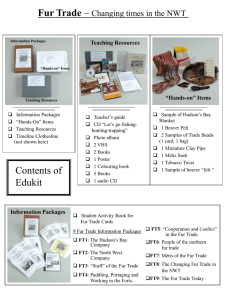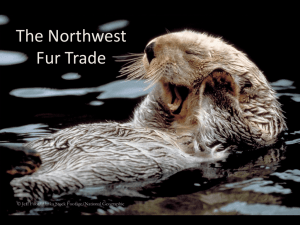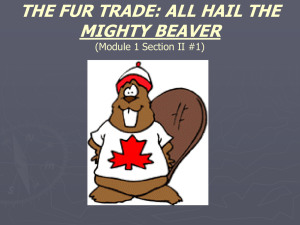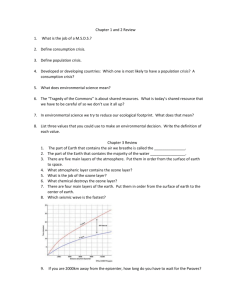225 East 17th Avenue, Suite 101 - Fur
advertisement
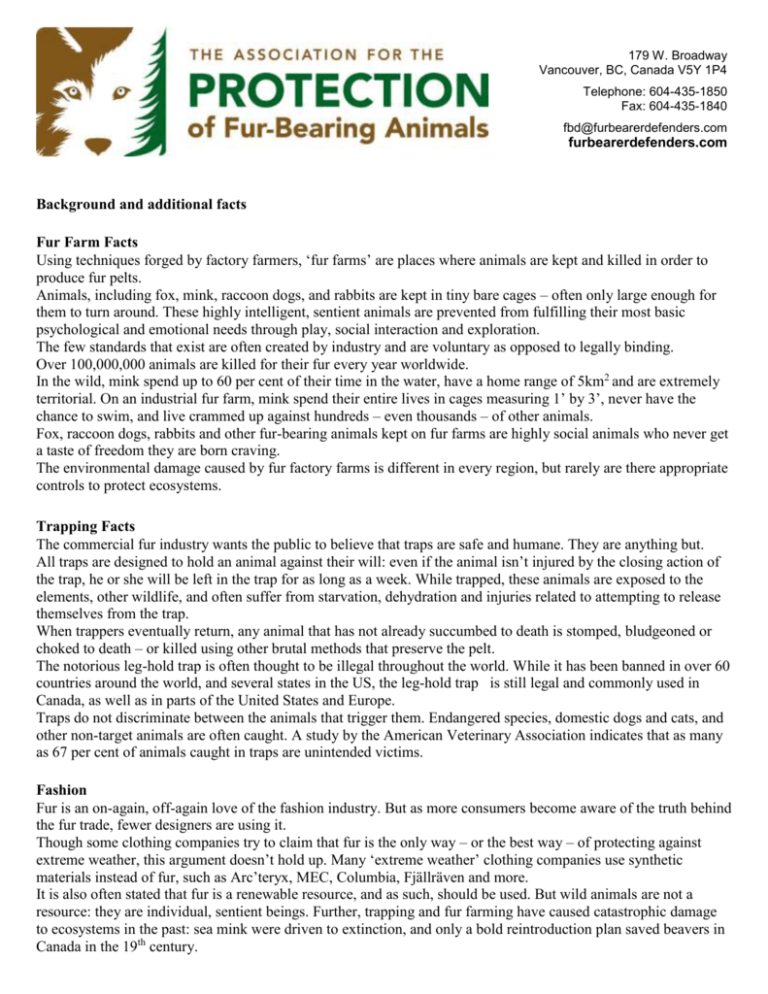
179 W. Broadway Vancouver, BC, Canada V5Y 1P4 Telephone: 604-435-1850 Fax: 604-435-1840 fbd@furbearerdefenders.com furbearerdefenders.com Background and additional facts Fur Farm Facts Using techniques forged by factory farmers, ‘fur farms’ are places where animals are kept and killed in order to produce fur pelts. Animals, including fox, mink, raccoon dogs, and rabbits are kept in tiny bare cages – often only large enough for them to turn around. These highly intelligent, sentient animals are prevented from fulfilling their most basic psychological and emotional needs through play, social interaction and exploration. The few standards that exist are often created by industry and are voluntary as opposed to legally binding. Over 100,000,000 animals are killed for their fur every year worldwide. In the wild, mink spend up to 60 per cent of their time in the water, have a home range of 5km2 and are extremely territorial. On an industrial fur farm, mink spend their entire lives in cages measuring 1’ by 3’, never have the chance to swim, and live crammed up against hundreds – even thousands – of other animals. Fox, raccoon dogs, rabbits and other fur-bearing animals kept on fur farms are highly social animals who never get a taste of freedom they are born craving. The environmental damage caused by fur factory farms is different in every region, but rarely are there appropriate controls to protect ecosystems. Trapping Facts The commercial fur industry wants the public to believe that traps are safe and humane. They are anything but. All traps are designed to hold an animal against their will: even if the animal isn’t injured by the closing action of the trap, he or she will be left in the trap for as long as a week. While trapped, these animals are exposed to the elements, other wildlife, and often suffer from starvation, dehydration and injuries related to attempting to release themselves from the trap. When trappers eventually return, any animal that has not already succumbed to death is stomped, bludgeoned or choked to death – or killed using other brutal methods that preserve the pelt. The notorious leg-hold trap is often thought to be illegal throughout the world. While it has been banned in over 60 countries around the world, and several states in the US, the leg-hold trap is still legal and commonly used in Canada, as well as in parts of the United States and Europe. Traps do not discriminate between the animals that trigger them. Endangered species, domestic dogs and cats, and other non-target animals are often caught. A study by the American Veterinary Association indicates that as many as 67 per cent of animals caught in traps are unintended victims. Fashion Fur is an on-again, off-again love of the fashion industry. But as more consumers become aware of the truth behind the fur trade, fewer designers are using it. Though some clothing companies try to claim that fur is the only way – or the best way – of protecting against extreme weather, this argument doesn’t hold up. Many ‘extreme weather’ clothing companies use synthetic materials instead of fur, such as Arc’teryx, MEC, Columbia, Fjällräven and more. It is also often stated that fur is a renewable resource, and as such, should be used. But wild animals are not a resource: they are individual, sentient beings. Further, trapping and fur farming have caused catastrophic damage to ecosystems in the past: sea mink were driven to extinction, and only a bold reintroduction plan saved beavers in Canada in the 19th century. Whether it’s fur from industrial factory farms or animals trapped in the wild, fur for fashion is unnecessary and always cruel. Legislation Canada Federal: In Canada there is no federal legislation governing the raising of animals on fur farms or the trapping of wild animals for fur. Though the Criminal Code of Canada technically covers fur-bearing animals, it is not preventative (in that it does not create minimum standards for the housing, care and handling of animals) and is only applicable once the cruelty or neglect has occurred. Additionally, the animal cruelty provisions of the Criminal Code have remained largely unchanged since 1892 and are fail to provide adequate protection for animals, which is why every province in Canada has adopted provincial animal welfare legislation. Unlike many other countries, Canada does require mandatory labelling of fur. Thus, real fur does not have to be labelled as such, neither does the species of animal used have to be identified. Canada also lacks regulations limiting the importation and sale of dog and cat fur. National Codes of Practice: The NFACC codes of practice are a set of voluntary guidelines relating to the housing, care and handling of animals. The most recent codes for fur farmed animals are the Mink and Fox Codes which were published in 2013. The only province that has adopted the Codes of Practice into provincial legislation, giving them force of law, is Newfoundland and Labrador. In all other provinces, the codes are not being enforced. Provincial Legislation Legislation governing fur-bearing animals differs in every province. The majority of provinces require a permit in order to operate a fur farm, but don’t require any specific standards to be met in order to obtain this permit. All provinces require a permit to trap fur-bearing animals, but regulations governing how often traps must be checked vary greatly from one province to another. In all provinces, except for Quebec, all animals in captivity - including fur-bearing animals - are covered by the province’s main animal protection law,. However, in each province, this legislation contains an exemption for common agricultural practices. This means that even if practices used on fur farms cause suffering or distress to animals (and would therefore normally be prohibited), provided a certain proportion of the fur industry uses that practice, it will be considered legal. Municipal by-laws: While most municipalities do not have by-laws relating to fur-bearing animals, some municipalities have come to realize that they can enact legislation that protects fur-bearing animals from being trapped or farmed. The Association for the Protection of Fur-Bearing Animals has been successful in working with several municipalities in British Columbia to ban traps. United States Federal: On a federal level there is very little US law that regulates the treatment of fur-bearing animals. Trapped and farmed fur-bearing animals are exempt from the Federal Animal Welfare Act that ensures for the humane treatment of animals, as well as from the Humane Methods of Slaughter Act, which requires livestock to be slaughtered humanely to prevent “needless suffering.” Federal legislation does exist related to the mandatory labelling of fur as well as to the prohibition on importation, exportation and sale of dog and cat fur. State: Legislation relating to trapping and fur farming does exist on a state level. However, most of the state legislation governs the licensing or obtaining of permits for trapping or fur farming but does not include any animal welfare standards. Some states, however, prohibit the use of the leg-hold trap. As is the case in Canada, most fur farmed animals fall under state animal cruelty legislation, but this legislation contains exemptions for hunting, trapping and fur farming, such that any suffering incurred by animals, provided it is caused by practices prevalent in the industry– is permitted. For more detailed information on US State legislation relating to the trapping of fur-bearing animals, click HERE https://www.animallaw.info/statutes/topic/fur-or-trapping (only available in English) For more detailed information on US State legislation regarding fur-farming and other legislation protecting furbearing animals, click HERE - https://www.animallaw.info/article/detailed-discussion-fur-animals-and-furproduction (only available in English) Outside North America Laws related to fur-bearing animals vary greatly around the world. Many parts of the European Union (EU) have strictly regulated or prohibited fur farming and also prohibit the use of leg-hold traps for trapping and the importation of dog/cat fur or seal products. Conversely, countries like China, which produces the majority of fur used throughout the world, have virtually no laws protecting fur-bearing animals. Israel is currently exploring the adoption of legislation which would prohibit the sale of fur anywhere in the country.
